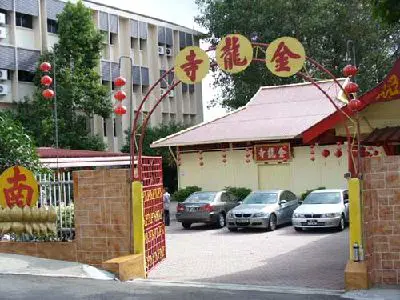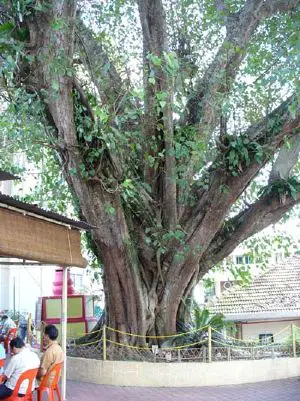Jin Long Si Temple
Jin Long Si Temple (Simplified Chinese: 金龙寺; Traditional Chinese: 金龍寺; pinyin: jīn lóng sì), located on a hilltop at Lorong How Sun (off Bartley Road), represents a unique "san-jiao" (three religion) village temple in Singapore, with its teachings derived from the books of Buddhism, Taoism, and Confucianism. Singapore has long had a tradition of respecting the three religions Confucianism, Buddhism, and Daoism. San-jiao (three religions) practiced at the Jin Long Si Temple exemplifies that tendency. San-jiao developed uniquely in Singapore, Jin Long Si Temple constituting the main temple for the faith in Singapore.
Although Jin Long Si Temple respects and regards Taoism and Confucianism, Buddhism's predominance has been indicated by the concern for the preservation of a Bodhi tree on the current property slated for eviction to build a subway station. The Bodhi tree, a symbol of Buddha's enlightenment, has entwined its roots into the foundation of the temple. The temple can not be destroyed without killing the priceless Bodhi tree. The Jin Long Si Temple Bodhi tree, grown from seeds brought from Sri Lanka, has stood on the spot for 120 years. The three religion temple allows us to envision a time in which religions harmonize, collaborate for the good of all, and avoid sectarianism.
History
Jin Long Si Temple, originally known as Jin Long Miao, constituted under a trust, had been established as a religious and charity mission in 1941, with funds and donations from philanthropic Chinese merchants. Founded to provide public shelter and a place of worship for the Chinese community during the period of great uncertainty of an imminent war sweeping through South East Asia in the 1940s,[1] the temple started off as an attap hut on a land donated by a grateful devotee earlier.

Wan Guan Lin later rebuilt it into a zinc-roof and wooden structure, remaining almost unchanged ever since. Displaying much resourcefulness and artistic talent, the devotees constructed a huge statue of the Laughing Buddha out of saw dust, a pagoda and also a pavilion with the life-size figure of their patron deity, Nan Wu Wu Ji Sheng Mu. While the temple takes the direction of a Chinese Mahayana Buddhist temple, its teachings represent a fusion of the "san-jiao" (three religion) derived mainly from Buddhism, Taoism and Confucianism. The temple also has many unique Taoist deities like Nan Wu Wu Ji Sheng Mu and Pan Gu (盘古), demonstrating a high level of religious tolerance and acceptance by the temple's community since its early days.[1] Every Sunday afternoon the taped teachings of the temple's late master play, especially to the elderly devotees in Hokkien dialect.
Occupying an area of 1,840 square meters, the temple has approximately 4,000 regular worshipers and more than 300 registered members. It provides free vegetarian meals each day to more than 100 aged and impoverished devotees residing near the temple.[1] The temple has also been active in contributing to the grassroots organizations in Braddell Heights with funds and manpower despite modest resources. The Straits Times featured a notable example in that the temple regularly sponsors functions for its next door neighbor, the Ramakrishna Mission Home for orphans and wayward boys. To reciprocate their kindness, the home opened its gates for the devotees to take a short cut through its premises for those walking uphill to the temple.[2]
Ancient Bodhi tree
The Bodhi tree, considered sacred to all Buddhists, gains its significance when it sheltered the Buddha from the elements during his quest for enlightenment. The Buddha attained enlightenment subsequently under the Bodhi tree. Thus the Bodhi tree has come to symbolize the Buddha's enlightenment, his wisdom and compassion.
The Bodhi tree at Jin Long Si Temple numbered among the twelve seeds brought by monks from Sri Lanka in the nineteenth century. Approximately 120 years (as of 2008), the tree stands over thirty meters tall and has a girth of 8.5 meters. Verifications made by the Nature Society Singapore (NSS) and National Parks Board (Nparks) declare it the oldest and largest Bodhi tree in Singapore.[1] Its roots deeply embed into the slope of the hill on which the temple stands, even extending to the inner recesses of the temple premises. Any land development at the tree's location has a high likelihood of causing soil movement and undue stress to the tree roots. Due to its ancient age and its symbiotic relationship with the temple, both the Nature Society Singapore and National Parks Board have recommended that the government designate the Bodhi tree a 'Heritage Tree' after their findings. A 'Heritage Tree' receives protection from all harm and has lightning conductors installed with money from the Heritage Trees Fund. A panel of officials and nature-loving volunteers decide if a tree should be placed on the register, based on its appearance, height and girth, as well as its social, historical and educational significance.[3]
Jin Long Si Temple today
On January 20, 2003, the Urban Redevelopment Authority (URA) issued a compulsory land acquisition order to acquire the plot of land belonging to the temple as part of URA's redevelopment plan for a nearby Mass Rapid Transit (MRT) construction of the Circle Line Project (Phase III). The new rail-line stretches from Bartley Road to Marymount Road, and will have five stations along its 5.7 kilometers stretch. Planned in five stages, construction has started for the first two phases of the Circle Line, and the construction on the third phase, costing US$1.2 billion, (US$800 million) will take five years to complete.[4] As a result, both the temple and the Bodhi tree will have to make way for redevelopment in early 2008. The URA has moved to acquire the temple grounds to join with state land next to them so more homes can be built there. It said: "Given Singapore's limited land area, there is a need for a continuous effort to optimize the use of our land, especially at sites served by major public transport infrastructure such as the Circle Line and other MRT stations."
Public appeals
The temple has been offered an alternative site in Punggol, as well as compensation, but its management still hopes to stay. Since then, the temple has actively organized events to generate public awareness and support of its plight as well and has made repeated appeals to the relevant authorities to review their decision to acquire the temple, urging them to preserve the rare and ancient Bodhi tree found within its compound. As a result, considerable public and media interest has been generated in the fate of the temple and its Bodhi tree, as well as other gradually disappearing natural heritage landmarks. Bus loads of local visitors, as well as tourists from countries like Japan, Thailand and China, flock to the temple every weekend. Some visitors have set up blogs and started an online petition to save the temple and the Bodhi tree.[5]
The online petition mentioned how the Land Transport Authority spent US$200,000 in 2005 and changed the alignment of a stretch of Braddell Road to protect an 80-year-old angsana tree. It appealed to the authorities to show the same attitude to the Bodhi tree at Jin Long Si. A concerned reader wrote to the Straits Times Forum Page twice to highlight the issue:[6]
Being an environmentally friendly country, I think our Government should do its part to try to save this only one 100-year-old bodhi tree located at Jin Long Si Temple. Years of cutting down big and small trees for development have caused the temperature in our garden country to increase each year. A few years back, a contractor accidentally chopped down a big tree at Changi. Although the contractor or company was penalised, the damage had been done. Do we wait another 100 years to see such a rare tree in Singapore?[7]
Since 2003, the temple's management has continually received negative replies. The most recent joint reply by the Ministry of Law and the Ministry of National Development, dated March 23, 2006, states the National Parks Board and the Urban Redevelopment Authority will "assess and consider the merit" of keeping the tree but the temple may have to go.[8]
Relocation
In January 2008, three devotees filed a legal suit to save the temple site from government acquisition, alleging a violation of the Constitution. The High Court dismissed the case on February 25, 2008, on the grounds that "the devotees had no standing to make the application."[9]
The temple received two months to relocate to a temporary site, and subsequently to a permanent home in Tai Seng Avenue. The temple's land will merge with state land next to it, for sale in the second half of 2008. The Government finally confirmed that the Bodhi tree will be retained by imposing for its preservation as part of the tender conditions for the redevelopment of the site.[9] Jing Long Si has relocated its premises on a plot of land at 32 Tai Seng Ave, Singapore.
Notes
- ↑ 1.0 1.1 1.2 1.3 Archived news of Jin Long Si Temple Jin Long Si Temple.
- ↑ "Homing in on harmony," The Strait Times, March 30, 2007.
- ↑ "NParks starts register to track rising number of heritage trees," The Straits Times, April 23, 2006.
- ↑ Karamjit Kaur and Ginnie Teo, "Temple to go to make way for MRT Circle Line," The Strait Times, January 21, 2003.
- ↑ Hui Yee Tan, "Visitors flock to save revered Bodhi Tree," The Strait Times, August 19, 2006.
- ↑ April 11, 2007 and July 18, 2007.
- ↑ Siek Moi Ng, "Save our only 100-year-old bodhi tree," The Strait Times, April 11, 2007.
- ↑ Arti Mulchand, "100-year-old tree may save temple," The Straits Times, April 21, 2006.
- ↑ 9.0 9.1 Shing Huei Peh, "High Court dismisses bid to save temple site - Jin Long Si has two months to relocate to site offered by Govt; acquired land to be used for homes," The Strait Times, February 26, 2008.
ReferencesISBN links support NWE through referral fees
- Comber, Leon. Chinese Temples in Singapore. Singapore: Eastern Universities Press, 1958. ASIN B002O7412A
- Lip, Evelyn. Chinese Temple Architecture in Singapore. Singapore: Singapore University Press, 1983. ISBN 9971690640
- Tan, Kevin, and Patrick Yew Weng Leong. The Temple and the Tree: Singapore's Jin Long Si." Singapore: Jin Long Si Temple, 2007.
- Tong, Chee Kiong. Trends in Traditional Chinese Religion in Singapore. Singapore: Ministry of Community Development, 1989.
External links
All links retrieved March 28, 2023.
Credits
New World Encyclopedia writers and editors rewrote and completed the Wikipedia article in accordance with New World Encyclopedia standards. This article abides by terms of the Creative Commons CC-by-sa 3.0 License (CC-by-sa), which may be used and disseminated with proper attribution. Credit is due under the terms of this license that can reference both the New World Encyclopedia contributors and the selfless volunteer contributors of the Wikimedia Foundation. To cite this article click here for a list of acceptable citing formats.The history of earlier contributions by wikipedians is accessible to researchers here:
The history of this article since it was imported to New World Encyclopedia:
Note: Some restrictions may apply to use of individual images which are separately licensed.

